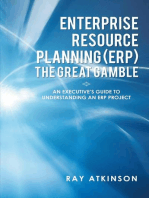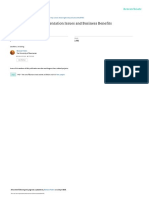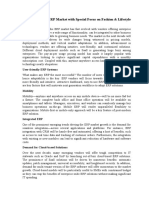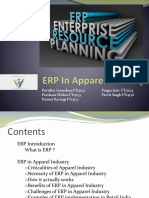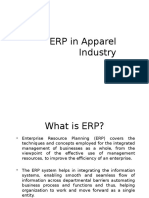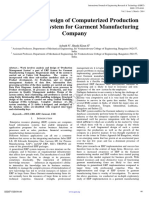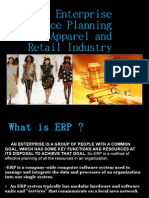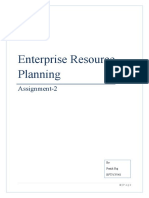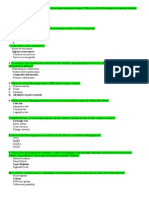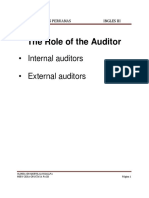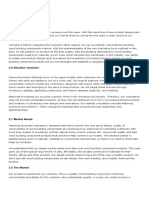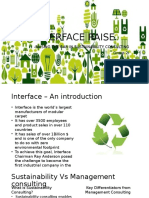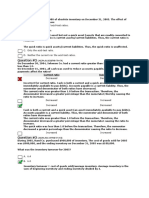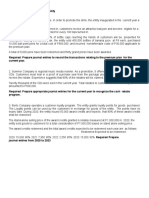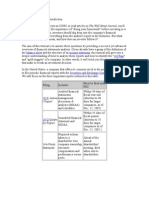ERP Implementation in Bangladesh Garments Industry For Effective Chain Management
ERP Implementation in Bangladesh Garments Industry For Effective Chain Management
Volume 9, Issue 11, November – 2024 International Journal of Innovative Science and Research Technology
ISSN No:-2456-2165 https://doi.org/10.38124/ijisrt/IJISRT24NOV1025
ERP Implementation in Bangladesh Garments
Industry for Effective Chain Management
S M Farhana Iqbal; Md. Abdullahel Shafi ; Dr. Md. Humaun Kabir
Associate Professor, Yarn Engineering Department, Bangladesh University of Textiles, Dhaka
Lecturer, Department of Electrical and Electronic Engineering, City University, Dhaka, Bangladesh
Vice Chancellor, Prime University, Dhaka, Bangladesh
Abstract:- The use of technology and information is and address supply chain problems while on the move. This
crucial for keeping up with emerging business trends as program will aid in preserving consistency in trade company
the Industrial Revolution 4.0 expands and heads towards buying behaviour, tracking online transactions, managing
5.0. Particularly crucial is the use of enterprise resource delivery schedules, and computing overall sales based on
planning (ERP) for enterprise management. ERP systems shifting margins. [1]
aid companies in managing projects and resource
utilization while reducing time and effort expenditure. With their labour-intensive structure and employment-
The procedures are carried out mechanically rather than friendly character, small and medium-sized businesses (SME)
by hand. Errors are prevented by the system's in the clothing manufacturing industry have also made a
simultaneous proper and efficient operation. ERP data substantial contribution to socioeconomic growth. Within the
allows businesses to make important decisions. In the whole manufacturing business as well as across all economic
fashion sector, the business and product standards are sectors, the sector continues to be the one that creates the
very dissimilar. It is essential to have an ERP system that most jobs. In the apparel manufacturing sector, women make
can manage purchases as well as handle inventory items, up around 75% of the workforce. Thus, the industry makes a
pricing, corporate structures, and campaign significant contribution both socioeconomically and
management. ERP features include a system with a huge otherwise. [2]
number of data, the use of a top-down strategy that
enables production chain management to be attentive, In the Philippines, labour costs of garments industry are
and the realization of complete ERP system management. getting higher every year because the government legislates
The ERP system has improved control over the higher wages. On top of this, the Philippines has a reputation
manufacturing chains in many businesses. This essay for having strident unions that in the past years paralysed
examines the use of ERP in the apparel sector and garments factories that employed many thousands of workers.
examines some of the possible advantages. The [3]
information used in this study was compiled from several
academic sources as well as other sources like reports and Additionally, there are a lot of problems in the clothing
other materials. At the conclusion of the paper, the sector, particularly with production management. The
conclusions and suggestions were discussed. process of making clothes is a planned operation that
Manufacturing organizations may profit from ERP includes steps like laying, marking, cutting, sewing, checking,
systems in today's hyperconnected, data-driven economy finishing, pressing, and packing. This procedure transforms
if staff receive proper training and reliable data, as the basic ingredients into final goods. If the preproduction phase
value of ERP systems directly depends on data quality. of material preparation is improperly carried out, production
will not be up to standard, making it difficult to maintain the
Keywords:- ERP, MRP, SME, Garment Industry, industry. This issue led to output or production estimates that
Bangladesh, Manufacturing, Management, Technology were off. [4]
Implementation.
The tracking of income has been another issue for the
I. INTRODUCTION clothing sector. The apparel industry faces a variety of
challenges, including seasonal demand, multi-channel
ERP software gives the sales staff more leverage by demand, and abrupt shifts in design, styles, and colours. In
providing essential customer data regardless of location, addition to this, economic complexity also affects customers'
device, or time. Administration may build appropriate tactics, purchasing power, which in turn affects the garment sectors'
board the precise audience for particular activities, and profit margins. Therefore, to analyse the previous
consider specific follow-up actions by using purchase performance of the sector and project for the future, effective
behaviour and considering the stage of the buyer client's ERP system tools are required. According to a recent study
journey. Due to the automated inventory and production report, using the right tools may raise sales by 2% to 5% and
processes, ERP provides management with the necessary decrease inventory by 7% to 15%. A new product
tools to handle vendor and customer inquiries. Customer introduction might be profitable up to 20% of the time. Thus,
information teams can instantly access customer information putting the approach into practice improves revenue
IJISRT24NOV1025 www.ijisrt.com 994
Volume 9, Issue 11, November – 2024 International Journal of Innovative Science and Research Technology
ISSN No:-2456-2165 https://doi.org/10.38124/ijisrt/IJISRT24NOV1025
management and deepens collaboration between executives A variety of issues, such as low rates of production and
and operational management. [5-7] efficiency, protracted lead times, high prices associated with
quality, and low rates of "Right First Time," are plaguing
Examining how the Bangladeshi textile and apparel Bangladesh's ready-made garment (RMG) industry. Overseas
industries may employ cutting-edge ERP software to clients are ultimately subjected to an excessive level of risks
streamline manufacturing processes is the major goal of this and uncertainties as a result of these problems at the RMG
study. Just-in-time production and total quality control are manufacturer's end. These problems could be resolved by
two operational objectives that have been merged during the implementing a variety of lean techniques. This study
past 20 years. Bangladeshi companies are realizing that employed qualitative research methods to assess the adoption
higher quality may result in less inventory, which helps find of lean practices in Bangladesh's RMG sector. A few of the
hidden quality problems. Supplier and customer relationship important improvements include pull production, a stronger
management are two important areas where interfirm focus on just-in-time production, the establishment of cross-
advantages may be observed. The following research functional quality inspection teams, and enhanced
questions form the basis of the study: information exchange via the enterprise resource planning
system. Despite the substantial advancements, the senior
How is ERP implemented in the garments industry of management of Bangladesh's RMG producers still has to
Bangladesh? develop a thorough plan as well as a distinct vision, goal, and
objectives before putting them into action. Data from imports
What are the potential benefits of implementing ERP in into Europe and the US indicate that Vietnam will likely
small, medium and large-scale cloth manufacturing surpass Bangladesh in 2020, dethroning Bangladesh's RMG
industry? industry from its position as the second-largest garment
exporter in the world after China. The World Trade
In this study, the qualitative method will be used, and Organization has not yet released comparable data for global
primary and secondary sources of data will both be used to exports in 2020. [9,10]
collect data. When compared to secondary data sources,
which include papers, books, literature, and online surveys, A. Demand Side
primary data sources are those that acquire data directly from The garment product has a very broad variety, a rigid,
informants. The textile and apparel industry will provide data. short-lived supply chain, erratic, variable demand, and a short
The management team will be contacted in the second stage life cycle (summer items, winter products, etc.). In order to
of this study by email, Facebook, LinkedIn, and other social predict demand and, thus, be able to create the optimal
media sites in order to ask them to participate in an online product, the textile and clothing industry engages in demand
survey. side activities including studying customer expectations,
social trends, upcoming events, seasonal changes, etc. The
II. PRESENT STATE OF THE GARMENT research and development divisions of corporations are
INDUSTRY IN BANGLADESH responsible for these projects. The textile and clothing
industry in Bangladesh have completely shifted its attention
There is no denying that Bangladesh's biggest export to exports. The government helps this industry by a variety of
industry, readymade garments (RMG), has been instrumental means, including the duty-free importation of raw materials,
in the country's economic revival. financial incentives, duty drawbacks, back-to-back financing,
and bonded warehouses. Not all companies with an export-
This sector accounts for 83% of all export earnings for oriented strategy sell their finished products on the local
the country. Bangladesh's garment industry has advanced to market. Completed garment imports are used to satisfy local
this point since the 1980s. The late Nurool Quader Khan demand. [10-15]
created the ready-to-wear industry in Bangladesh. He could
see how the country could be altered. In 1978, he sent 130 B. Supply Side
trainees to South Korea to study the production of ready-to- When the manufacturing contract is signed, the supplier
wear garments. He founded the first factory, called "Desh prepares for the production process. Here is where the supply
Garments," with the aid of those trainees to produce garments side of the demand-supply chain begins. The supply side
for export. The business has grown and matured throughout includes acquiring raw materials, producing clothing,
the years thanks to a variety of inspiration sources. In 1995, delivering finished goods, and maintaining a good working
after becoming aware of child labour in 1994, we were able relationship with buyer-distributors. The earliest phase of the
to completely eliminate it from our industry. Our industry supply side is the acquisition of raw materials, often known
was able to establish itself, develop through time, and evolve as the industry's backward linkage. The many types of raw
thanks to the MFA-quota. Many people projected that the materials are categorized as fiber, yarn, fabric, wet
phase-out would cause a big disruption in our export when processing, and accessories. At the top of the value chain,
the quota was due to expire in 2004. However, the post-MFA fiber makers create materials out of natural or synthetic
era is a different success story. We overcome the post-MFA resources. According to the US Department of Agriculture,
issues and disproved every prognosis. The garment industry Bangladesh imports 99 percent of its raw cotton (USDA). [10,
is presently Bangladesh's major source of foreign exchange 15]
earnings, with exports totalling more than $27.9 billion in the
2019–20 fiscal year. [8]
IJISRT24NOV1025 www.ijisrt.com 995
Volume 9, Issue 11, November – 2024 International Journal of Innovative Science and Research Technology
ISSN No:-2456-2165 https://doi.org/10.38124/ijisrt/IJISRT24NOV1025
In the textile and garment sectors, foreign fiber and yarn sources of growth in Asia's quickly developing economy.
predominate. Imports of raw cotton increased by 3.1 times, Heavy equipment activities used in the clothing industry
imports of staple fibers by 6.9 times, and imports of yarn by necessitate efficient execution of intricate production
3.2 times as compared to the fiscal year 2005-2006. In terms processes. Therefore, ERP systems are often used for
of exports of clothing, imports of staple fiber and yarn are business operations by Bangladeshi enterprises. To
rising, while imports of raw cotton remain mostly unchanged. understand their use, we shall talk about Ha-Meem Group
Private fabric makers in Bangladesh may be able to provide and Squares styles in this section. [19]
the majority of the industry's demand for knit fabric. The
woven fabric sector, however, still depends on imports. A. Material Requirements Planning
Fibers are used to make yarn. To make yarn, short, natural According to demand and the bill of materials, a
and synthetic fibers are spun, thrown, and smoother texture. material requirement planning (MRP) system decides the raw
Over the previous 10 years, imports of raw cotton fiber materials, components, and subassemblies that are required
climbed on average by 17% while imports of staple fiber as well as when to assemble the finished products. MRP II,
increased on average by 29%. Imports of staple fiber or manufacturing resource planning, employs software
increased by 138% while imports of raw cotton fell by 22%. programs to arrange evolving operations. Additionally, it
The growth rate of imported yarn decreased as domestic covers processes for component purchasing, product
manufacturing of yarn began to replace imports. Thus, in the assembly, inventory control, and product delivery.
import chain for raw materials, staple fiber replaces raw
cotton. The CAGR was 12.8% for raw materials and 12.4% B. Enterprise Resource Planning
for clothing, respectively. Imported raw materials accounted Through carefully planned divisions like item
up 19% of the exported finished goods. [10,16] scheduling, component procurement, stock control, product
supply, completion, and order tracking, an ERP system
III. STAGES OF ERP SYSTEM commonly combines corporate operations. Application
segments for supporting sales & marketing, human resources,
Enterprise resource planning, or ERP, is a networked finance, and accounting may be included in ERP software
software framework designed to integrate the key functional architectures. Large corporations used it at the time to their
parts of a company's business activities into a single full advantage. However, the bulk of small and medium-sized
integrated system. Business operations including those in businesses were left out owing to the higher starting costs.
human resources, finance, buying, supply, and other relevant
divisions are regulated, streamlined, and assimilated by ERP In the 2000s, systems with ERP capabilities
software. [17] Manufacturing resource planning (MRP II) incorporated increasingly sophisticated features, such web-
and material requirements planning (MRP) that expanded based internet functionality. The ERP II system's most
outside of manufacturing into other zones of the firm, mainly crucial features were these characteristics. It can, for instance,
finance and human resources, were first described by Gartner be integrated with CRM systems. The development of
in 1990. Material management, sales and distribution, technology makes it possible to retrieve information via
production planning and management, quality control, mobile devices and web-based browsers. ERP II's
costing, human resources and payroll, finance, and introduction of Services Oriented Architecture (SOA)
controlling are important ERP components. changed technological development.
ERP solutions are useful for manufacturing companies Software as a Service is also used to supply commercial
of all sizes. Modern industrial firms must use solutions and applications (SaaS). IT servers are set up on cloud platforms
tools that may help them accelerate their growth and create and accessed by Android, iOS, APIs, browsers, and programs
data-driven values so they can make informed decisions. The created for delivering ERP applications in the SaaS
power of analytics and big data is immeasurable in today's framework. These commercial apps help both small and big
hyperconnected and data-driven economy. By integrating enterprises utilize ERP systems effectively since cloud ERP
various internal operations, ERP systems not only enhance solutions have a lower upfront cost than other types of ERP
production and distribution but also provide a 360-degree systems.
perspective of the whole firm. One must consider a number
of criteria, such as our budget, implementation targets, Online access is required to use cloud ERP, or
timeline, and necessary structures, in order to install the best enterprise resource planning, software. Cloud ERP software
manufacturing ERP system. For many firms, enterprise provides cutting-edge capabilities for all essential company
resource planning may be a highly successful undertaking. operations and forms the basis of an organization's IT
[18] infrastructure. Cloud ERP is commonly made available "as a
service" on the cloud computing infrastructure of a provider
The design, manufacture, and distribution of yarn, cloth, (software-as-a-service or SaaS ERP). Instead of purchasing
and clothing are mostly handled by the textile industry's the program completely, customers may lease it by paying an
management. The industrial processes and procedures used to annual or monthly fee. Hardware start-up costs are not
produce clothing on a large scale for commercial purposes. incurred; instead, the provider handles application
The textile and apparel business are a significant economic, maintenance, innovation, data storage, and security. [19-21]
social, health, and environmental sector for both Asia and
Europe. The textile and apparel industries are one of the main
IJISRT24NOV1025 www.ijisrt.com 996
Volume 9, Issue 11, November – 2024 International Journal of Innovative Science and Research Technology
ISSN No:-2456-2165 https://doi.org/10.38124/ijisrt/IJISRT24NOV1025
IV. ERP IN BANGLADESH GARMENTS C. Managing All Business Operations:
INDUSTRY The hub of a clothing store's operations is its ERP
software. Every department, including sales, production,
Right from the start, ERP covers a deep and inventory, finance, warehousing, supply chain, human
comprehensive operation by combining all the data into a resources, etc., may be tracked and managed. On the
single data model. Bangladesh's garment industry is being dashboard, users may obtain a detailed view of any
modernized with the use of ERP software. It works best for department whenever necessary. Additionally, coordination
the clothing sector. It consists of operations for between various activities and departments is made possible
manufacturing, supply chain management, human resources, by the integrated platform. Anyone with access to the system
and distribution. is able to enter data, amend it, update it, and submit it for
processing. Teams are therefore not compelled to check in
A solid ERP system offers the answer to all of these with one another for information or updates. For efficient
problems. It is essential to organizing all of your activities corporate procedures, the ERP software improves
and boosting productivity. The advantages of an ERP system cooperation and communication across various departments.
for your clothing or apparel firm are as follows:
D. Managing All Business Operations:
A. Inventory Tracking: The right ERP software centralizes the management of
People try to make fewer errors at a clothing store all a company's operations, saving time. By automating tasks
because there are so many different kinds of goods there. like data input, clothing ordering, customer emailing, etc.,
This may be accomplished by putting ERP software into companies may save time and lower the possibility of
practice. This may monitor the inventory's availability, mistakes. The roles and duties as well as access rights for the
operational efficiency in moving inventory, and management ERP system may also be precisely defined. With ERP,
of shortages and surpluses. Anyone can keep a careful check organizations practice lean manufacturing, which reduces
on your inventory depending on colour, size, styles, etc. waste and, as a result, costs money. These processes all
thanks to the barcode scanning technology. Using the ERP operate on schedule, resulting in cost savings and accuracy at
software, companies can control their inventory and decide the conclusion of each stage. Additionally, users can observe
wisely when it counts. all of your processes in real-time and keep an eye on them
from a distance to find any gaps. By correcting them, can
B. Generating Customer Insights: improve process efficiency and accuracy, which boosts
Data about clients and the features of their buying productivity.
behaviour may be fed into the ERP system. This information
is kept safe and secure in the database. This information can Figure 1 exhibits the utilisation trend of ERP software
be further examined to produce insights. Companies can amongst the Bangladeshi garments industry since the
anticipate changes in consumer needs and purchase a new formation of BGMEA for a sample size of 600 companies. It
batch of goods in response. Additionally, organizations may clearly demonstrates that over the last decade the
base the marketing plans on consumer behaviour to improve implementation and reliance on data driven decision making
the purchasing experience. has gained undeniable momentum.
Fig. 1 Growth in ERP system usage by the Bangladeshi Garments companies.
IJISRT24NOV1025 www.ijisrt.com 997
Volume 9, Issue 11, November – 2024 International Journal of Innovative Science and Research Technology
ISSN No:-2456-2165 https://doi.org/10.38124/ijisrt/IJISRT24NOV1025
V. METHODOLOGY Integration of the ERP system with supply chain
management.
Multitude of data acquisition approach was adopted in Demand, orders, and inventory keeping methods to input
this study with the responding sample size totalling 600 in the ERP system.
garments. Initially a list of garments factories was established
along with their email, and other form of contact point as per Questions were raised regarding the substance of the
the official website of Bangladesh Garment Manufacturers ERP adoption model, different components, application
and Exporters Association [BGMEA] that has 3,665 phases, and the importance of each component at each level.
members. [22] The order of activities in each phase of the implementation
and other criteria that had previously been recognized by the
A questionnaire was emailed to each email, and the study literature and the expert panel were also questions that
reply from the cooperating companies were compared. For were put to the interviewees. The second interview phase was
those who did not respond to the email questionnaire, they semi-structured, allowing the subject to provide replies as
were called over phone and WhatsApp to ask the base they saw fit while the investigation was done in the order
questions, and/or for an appointment to visit their factory site. related to the model. In other instances, interview questions
Those remaining handful were visited to take interview of the were condensed in a different way to meet the demands of
person in charge of the operation in different departments of interviewers with varying backgrounds, expertise, and traits.
the company.
The results of the survey have been presented in Figure
The questionnaire comprised the following queries: 2 and Figure 3. Figure 2 displays the utilisation ratio of local
ERP the company is using. ERP software used in the Bangladeshi garments industry.
The features of the ERP the company utilises. Figure 3 shows the percentage of Bangladeshi companies
using international ERP software.
Fig. 2 Proportion of Usage of Different Bangladeshi ERP Software by the Garments Companies in the Country.
Fig. 3 Proportion of Bangladeshi Garments Companies using International ERP Software.
IJISRT24NOV1025 www.ijisrt.com 998
Volume 9, Issue 11, November – 2024 International Journal of Innovative Science and Research Technology
ISSN No:-2456-2165 https://doi.org/10.38124/ijisrt/IJISRT24NOV1025
VI. DISCUSSION ON FINDINGS the firm; (5) ERP software helps small and medium-sized
enterprises to react rapidly to client requests and feedback.
Technology must be used to address issues including Therefore, using a CRM solution will help SMEs become
lack of flexibility, security, and interaction with existing more responsive.
systems. Since technology makes it simpler to automate daily
chores, it essentially eliminates the possibility of human The findings indicate that employees are worried about
mistake and secures the man hours. It entails concluding the ERP's operational capabilities and vendor-related difficulties.
automated procedures offered by the manufacturing ERP, As a result, I advise businesses to utilize ERP with regulation
which cover a variety of operations including sales, purchase and compliance capabilities to aid in the administration of
records, human resources, stock, and other areas. Automation human resource regulation at each step and information
frees up time, enables businesses to obtain timely data, and security. A system of established standards known as quality
gives them greater control. Various components of supply control is used to ensure that manufactured goods fulfil the
chain and distribution management are outlined, including organization's quality objectives. The most crucial
warehouses, packaging suppliers, vendors, logistics, and component for success is quality. A comprehensive
point of sale for various brands and retail chain organizations. inspection and testing of the product are required as part of
For the business to expand, a proper supply chain and quality assurance. With the use of alarm mechanisms and
distribution management strategy is essential. level-by-level evaluative processes, the ERP software aids in
the monitoring and tracking of various quality management
Respondents said that they encountered many and processes.
complex technical problems when using the ERP system. As
a result, management frequently uses more raw materials Comprehensive training is required since industrial
than necessary and frequently encounters shortages as a companies use ERP software. We may also study and use
result of this. Therefore, the organization needs enhance staff cutting-edge technologies like cloud migration, artificial
training to use manufacturing ERP software that offers real- intelligence, two-tier systems, and the Internet of Things.
time view of incoming work orders. The users may use this ERP systems that are cloud-based eliminate the requirement
information to manage their inventory needs and make sure to be present at your desk at work, which has implications for
that the right resources are available at the right time to meet your team as well. The likelihood of a successful ERP
those needs. Such precise information can help reduce installation is higher in a setting that values and rewards
downtime and boost customer satisfaction. Since the teamwork and open lines of communication. It's crucial to
employees are fully informed of the supplies to get, even if keep everyone informed with frequent updates and training
this necessitates relying on several suppliers to meet such sessions to guarantee a seamless ERP installation.
needs, such projections will also reduce the overstock. The
team will automate this logistical procedure and free up the The software will also manage the dates when the
workforce to address other supply chain concerns in a checking up on maintenance are still needed to be checked
proactive manner by using the ERP system in production. plus send the reminders. All these will assist in utilizing the
apparatuses optimally plus increase the life of the machines.
Related data and investigations were obtained based on Integration of ERP systems is a challenging procedure that
the approach used by the researchers. Following that, the needs careful planning and strategy. It takes between six
following are some, if not all, benefits of ERP for SMEs: (1) months and two years to integrate client and server systems.
It is possible to decrease data entry mistakes, especially if the Although modifications and changes are inevitable, it is
data does not need to be entered into the system. Additionally, crucial to design an ERP project before integration for a
if unnecessary procedures are skipped, excessive amounts of successful deployment.
paper documents are eliminated, and manual labour for
inventory is reduced, cost savings can be gained; (2) As the Before choosing whether data has to be integrated into
conventional paper papers are replaced with electronic copies, the new system, analyse the old data to eliminate any
operational efficiency has grown. The capacity to compete extraneous information. If the data is inaccurate or contains
and fight alongside larger businesses and organizations may mistakes, the integration could not function. Management
be impacted by this. An ERP may assist in reducing IT and must develop a data integration strategy that collects data and
training expenses, as well as the time and effort required by divides it into logical tables.
staff to execute their everyday activities. When implemented
correctly, an ERP solution may dramatically reduce or Working with a solution provider early in your ERP
eliminate repetitive manual processes. Technically, this deployment will boost your chances of success and help you
enables team members to concentrate on profitable pursuits; avoid common blunders. Solution providers buy, set up, and
(3) A major advantage of ERP software is that it helps users initially implement ERP solutions. The best way to do it is to
gain better understanding. By implementing an ERP suite hire someone who has the necessary expertise and knowledge.
across divisions, all of the processes have a single, unified Businesses look for competent personnel to handle ERP
reporting structure. An ERP architecture provides a single alignment with their operations as a result.
source of authenticity, which makes it simple to create useful
reports and analytics at any moment; (4) The framework may
aid in the installation and use of best-practice procedures for
the industry, ensuring that all operations are integrated across
IJISRT24NOV1025 www.ijisrt.com 999
Volume 9, Issue 11, November – 2024 International Journal of Innovative Science and Research Technology
ISSN No:-2456-2165 https://doi.org/10.38124/ijisrt/IJISRT24NOV1025
VII. CONCLUSION [10.] Shams Ul Islam, and Md. Abdullahel Shafi. "Garment
Industry: Present Scenario in Bangladesh" International
In conclusion, the implementation of an ERP system in Journal Of Advance Research And Innovative Ideas In
the Bangladesh garments industry can greatly enhance the Education Volume 8 Issue 6 2022 Page 890-900.
effectiveness of supply chain management and an upward [11.] J Export Performance / Bangladesh Garment
trend of this can be seen in the trend of utilisation over the Manufacturers and Exporters Association (BGMEA)
years. By centralizing data and streamlining processes, an compiled data by Export Promotion Bureau.
ERP system can improve communication and collaboration https://bgmea.com.bd/page/Export_Performance.
between different departments and stakeholders, resulting in [12.] Fashion’s New Must-Have: Sustainable sourcing at
increased efficiency and cost savings. Additionally, the use scale, McKinsey Apparel CPO Survey 2019, McKinsey
of real-time data and analytics can provide valuable insights & Company, October 2019.
for decision-making and forecasting. The findings of this https://www.mckinsey.com/industries/retail/our-
study demonstrate that the advantages of installing ERP in insights/fashions-new-must-havesustainable-sourcing-
the Bangladeshi clothing industry significantly outweigh the at-scale.
upfront costs of the process and the training necessary for it. [13.] USITC; Eurostat
Therefore, it is recommended that the industry consider [14.] Lean practices in the Bangladeshi ready-made garments
implementing an ERP system to improve their supply chain industry and global significance,
management. https://doi.org/10.1080/13675567.2020.1847262
[15.] Bangladesh Textile Clothing Industry – A Supply
REFERENCES Demand Review, 2016
https://www.researchgate.net/publication/316275361_T
[1.] Wijewardhana, Ganguli Eranga Harshamali, et al. "New he_Bangladesh_Textile-
product development process in apparel industry using Clothing_Industry_A_DemandSupply_Review.
Industry 4.0 technologies." International Journal of [16.] Sen, A. (2008). The US fashion industry: A supply
Productivity and Performance Management (2020). chain review. International Journal of Production
[2.] Istanbul Chamber Industry. December 2012. Garment Economics, 114(2), 571–595.
Manufacturing Industry. Retrieved from doi:10.1016/j.ijpe.2007.05.022.
https://www.iso.org.tr/sites/1/upload/files/Garment_Ma [17.] Buck-Emden, Rüdiger. The SAP R/3 system: An
nufacturingIndustry_EN-685.pdf. introduction to ERP and business software rechnology.
[3.] New Cloth Market (July 2012). Philippines Garment Addison-Wesley, 2000.
Industry on the Growth Path. Retrieved from [18.] ERP For Manufacturing: Importance, Features and
https://www.fibre2fashion.com/industry- Benefits | SPEC INDIA. 2021, August 18. SPEC
article/6409/philippinesgarment-industry-on-the- INDIA; www.spec-india.com. Available at:
growthpath. https://www.spec-india.com/blog/erp-for-manufacturing
[4.] Textile School (March 2019). Garments Production Accessed 16.11.2022.
Process. Retrieved from [19.] Parvin, Farzana. "ERP-based management of garment
https://www.textileschool.com/193/garment- industry: Using ERP can make garment industry
productionprocess/#:~:text=Garment%20production%2 management more successful." (2022).
0is%20an%20organized,raw%20materials%20into%20f [20.] Kumar, R. 2022. Role of ERP Software in
inished%20products. Manufacturing Industry. Global Trade, 2-9.
[5.] Fibre2Faschion (2019). Sales and Operations Planning [21.] McCue, Ian. 2022. ERP Modules: Types, Features &
for Textile & Apparel Industries. Retrieved from Functions. Netsuite.Com. Available at:
https://www.fibre2fashion.com/industry- https://www.netsuite.com/portal/resource/articles/erp/er
article/4333/sales-andoperations-planning-for- p-modules.shtml Accessed 15.9.2022.
textileapparel-industries. [22.] Bangladesh Garment Manufacturers and Exporters
[6.] Larry Lapide, Sales and Operations Planning Part III A Association official website,
Diagnostic Model, The Journal of Business Forecasting, https://www.bgmea.com.bd/page/member-list
Spring 2005,
&sec=article&uinfo=<%=server.URLEncode(2094)%>
"target="_blank">http://ctl.mit.edu
[7.] Donald H. Sheldon, World class Sales and Operations
Planning, http://books.google.com
[8.] Garment Industry of Bangladesh,
https://www.bgmea.com.bd/page/AboutGarmentsIndust
ry.
[9.] Lean practices in the Bangladeshi ready-made garments
industry and global significance,
https://doi.org/10.1080/13675567.2020.1847262.
IJISRT24NOV1025 www.ijisrt.com 1000
You might also like
- Entrepreneurship Simulation The Startup Game - Wharton University of PennsylvaniaNo ratings yetEntrepreneurship Simulation The Startup Game - Wharton University of Pennsylvania46 pages
- Role of Information Technology in Apparel Industry100% (6)Role of Information Technology in Apparel Industry26 pages
- ERP For Textiles and Apparel Industry by Rathinamoorthy PDFNo ratings yetERP For Textiles and Apparel Industry by Rathinamoorthy PDF286 pages
- Enterprise Resource Planning (Erp) the Great Gamble: An Executive’S Guide to Understanding an Erp ProjectFrom EverandEnterprise Resource Planning (Erp) the Great Gamble: An Executive’S Guide to Understanding an Erp Project4.5/5 (5)
- ERP in Fashion: Implementation Issues and Business Benefits: September 2013No ratings yetERP in Fashion: Implementation Issues and Business Benefits: September 201313 pages
- Latest Trends in ERP Market With Special Focus On Fashion0% (1)Latest Trends in ERP Market With Special Focus On Fashion5 pages
- Apparel Quality Management 2: Assignment: 2No ratings yetApparel Quality Management 2: Assignment: 216 pages
- Importance of ERP Software in Textile IndustryNo ratings yetImportance of ERP Software in Textile Industry9 pages
- Enterprise Resource Planning: Assignment 1 Shubhi Srivastava BFT-6No ratings yetEnterprise Resource Planning: Assignment 1 Shubhi Srivastava BFT-69 pages
- Enterprise Resource Planning ERP: Ammar, Bilal, Toqueer &farhanNo ratings yetEnterprise Resource Planning ERP: Ammar, Bilal, Toqueer &farhan30 pages
- Key Benefits of ERP For Spinning and Textile IndustryNo ratings yetKey Benefits of ERP For Spinning and Textile Industry2 pages
- Enterprise Resource Planning: Presented By:-Gurnoor Kaur (BFT/18/620) Snigdha Das (BFT/18/616)No ratings yetEnterprise Resource Planning: Presented By:-Gurnoor Kaur (BFT/18/620) Snigdha Das (BFT/18/616)34 pages
- Enterprise Resource Planning in Textiles: Volume 2, Issue 3, Summer 2002No ratings yetEnterprise Resource Planning in Textiles: Volume 2, Issue 3, Summer 20020 pages
- Analysis and Design of Computerized Production Management System For Garment Manufacturing Company IJERTV3IS030140No ratings yetAnalysis and Design of Computerized Production Management System For Garment Manufacturing Company IJERTV3IS0301406 pages
- AnERPImplementationCaseStudyintheSouthAfricanRetailSectorHIS121TemplateNo ratings yetAnERPImplementationCaseStudyintheSouthAfricanRetailSectorHIS121Template15 pages
- A Study of the Supply Chain and Financial Parameters of a Small BusinessFrom EverandA Study of the Supply Chain and Financial Parameters of a Small BusinessNo ratings yet
- Enterprise Resource Planning in Apparel Industry0% (1)Enterprise Resource Planning in Apparel Industry16 pages
- Enterprise Resource Planning in Apparel and Retail IndustryNo ratings yetEnterprise Resource Planning in Apparel and Retail Industry36 pages
- Manufacturing Secret : Product Development and Intelligent Manufacturing For Flexible Automation With Odoo 17: odoo consultations, #1.1From EverandManufacturing Secret : Product Development and Intelligent Manufacturing For Flexible Automation With Odoo 17: odoo consultations, #1.1No ratings yet
- A Quantitative Study of Enterprise Resource Planning (ERP) System and It's ApplicationsNo ratings yetA Quantitative Study of Enterprise Resource Planning (ERP) System and It's Applications12 pages
- Enterprise Resource Planning: Sales and Marketing ModuleNo ratings yetEnterprise Resource Planning: Sales and Marketing Module29 pages
- Enterprise Resource Planning: Assignment-2No ratings yetEnterprise Resource Planning: Assignment-224 pages
- ERP An Overview and Challenges in ImplementationNo ratings yetERP An Overview and Challenges in Implementation10 pages
- Reaping the Benefits of Industry 4.0 through Skills Development in High-Growth Industries in Southeast Asia: Insights from Cambodia, Indonesia, the Philippines, and Viet NamFrom EverandReaping the Benefits of Industry 4.0 through Skills Development in High-Growth Industries in Southeast Asia: Insights from Cambodia, Indonesia, the Philippines, and Viet NamNo ratings yet
- What Organisations Should Know About Enterprise Resource Planning (Erp) SystemNo ratings yetWhat Organisations Should Know About Enterprise Resource Planning (Erp) System16 pages
- Enterprise Resource Planning: BATCH: 2009-2013100% (1)Enterprise Resource Planning: BATCH: 2009-201327 pages
- Implementation of Enterprise Resource PLNo ratings yetImplementation of Enterprise Resource PL11 pages
- Design_and_implementation_based_on_ERP_in_the_clotNo ratings yetDesign_and_implementation_based_on_ERP_in_the_clot4 pages
- Enterprise Resource Planning For Managing TodayNo ratings yetEnterprise Resource Planning For Managing Today11 pages
- Investigating the Interplay between Climate Change and Sustainable Environment Development: Challenges, Strategies and Future DirectionsNo ratings yetInvestigating the Interplay between Climate Change and Sustainable Environment Development: Challenges, Strategies and Future Directions11 pages
- Perception, Attitude, and Readiness in Artificial Intelligence Adoption among Academic Librarians in the Bicol Region Librarians Council (BRLC)No ratings yetPerception, Attitude, and Readiness in Artificial Intelligence Adoption among Academic Librarians in the Bicol Region Librarians Council (BRLC)6 pages
- Analysis of the Role of Websites, Design, and Performance Metrics in Improving Company Performance in Medan CityNo ratings yetAnalysis of the Role of Websites, Design, and Performance Metrics in Improving Company Performance in Medan City4 pages
- Transition to Telepsychotherapy: Experiential Perspective of Debutant TherapistsNo ratings yetTransition to Telepsychotherapy: Experiential Perspective of Debutant Therapists6 pages
- Monte Carlo-Based Modeling of 2-D Ising Systems Using Metropolis Algorithm, Simulation Techniques, Thermodynamic Behavior and Magnetization PatternsNo ratings yetMonte Carlo-Based Modeling of 2-D Ising Systems Using Metropolis Algorithm, Simulation Techniques, Thermodynamic Behavior and Magnetization Patterns16 pages
- Assessment of Underground Water Quality of Gosa Landfill Site of the Federal Capital Territory, Abuja NigeriaNo ratings yetAssessment of Underground Water Quality of Gosa Landfill Site of the Federal Capital Territory, Abuja Nigeria11 pages
- Developing Gamified Educational Technologies to Enhance Learning and Motivate Student Engagement in Education: A Quantitative Study Using Human-Computer Interaction (HCI)No ratings yetDeveloping Gamified Educational Technologies to Enhance Learning and Motivate Student Engagement in Education: A Quantitative Study Using Human-Computer Interaction (HCI)16 pages
- Crude Oil Price Volatility and its Impact on Nigeria’s Balance of Trade: An Empirical Assessment (2000–2023)No ratings yetCrude Oil Price Volatility and its Impact on Nigeria’s Balance of Trade: An Empirical Assessment (2000–2023)13 pages
- Optimal Voltage Regulation in Standalone Photovoltaic Systems Using Model Predictive Control and MOGANo ratings yetOptimal Voltage Regulation in Standalone Photovoltaic Systems Using Model Predictive Control and MOGA8 pages
- Cost Comparative Analysis of Solar/Utility and Diesel/Utility Hybrid Power System for a Typical Residential BuildingNo ratings yetCost Comparative Analysis of Solar/Utility and Diesel/Utility Hybrid Power System for a Typical Residential Building8 pages
- A Review on Gold Nanoparticles: Properties, Synthesis and Biomedical Application in Drug Delivery and Cancer TherapyNo ratings yetA Review on Gold Nanoparticles: Properties, Synthesis and Biomedical Application in Drug Delivery and Cancer Therapy6 pages
- A MIC-MAC-Based Structural Exploration of Determinants Impacting Investment SensitivityNo ratings yetA MIC-MAC-Based Structural Exploration of Determinants Impacting Investment Sensitivity8 pages
- A Phytochemical Evaluation of Sierra Leonean Cassia siamea: A Source of Bioactive CompoundsNo ratings yetA Phytochemical Evaluation of Sierra Leonean Cassia siamea: A Source of Bioactive Compounds5 pages
- Real - Time Recognition of Cardiovascular Conditions from ECG Images with Deep LearningNo ratings yetReal - Time Recognition of Cardiovascular Conditions from ECG Images with Deep Learning10 pages
- Analyzing Social Communication Deficits in Autism Using Wearable Sensors and Real-Time Affective Computing SystemsNo ratings yetAnalyzing Social Communication Deficits in Autism Using Wearable Sensors and Real-Time Affective Computing Systems17 pages
- Enhancing Model Accuracy for Keypoint-Based Sign Language Recognition using Optimized Neural Network ArchitecturesNo ratings yetEnhancing Model Accuracy for Keypoint-Based Sign Language Recognition using Optimized Neural Network Architectures7 pages
- Unlocking the Therapeutic Power of Coriander: A Review of Coriandrum Sativum’s Bioactive Compounds and Health BenefitsNo ratings yetUnlocking the Therapeutic Power of Coriander: A Review of Coriandrum Sativum’s Bioactive Compounds and Health Benefits15 pages
- Smart Narrator Robot: Enhancing Experiential Learning through Conditional AutonomyNo ratings yetSmart Narrator Robot: Enhancing Experiential Learning through Conditional Autonomy6 pages
- Assessing the Achievements of the Re-Alignment of an Industry Educatiocal Based System in SocietyNo ratings yetAssessing the Achievements of the Re-Alignment of an Industry Educatiocal Based System in Society5 pages
- Analysis of the Export Competitiveness of Indonesia's Horticultural Fruit Products in the International MarketNo ratings yetAnalysis of the Export Competitiveness of Indonesia's Horticultural Fruit Products in the International Market8 pages
- EduTech Portal: An AI-Powered Student Assistant ChatbotNo ratings yetEduTech Portal: An AI-Powered Student Assistant Chatbot12 pages
- Architecture as a Reflection of Cultural Continuity: A Study of Traditional TrendsNo ratings yetArchitecture as a Reflection of Cultural Continuity: A Study of Traditional Trends3 pages
- Development of Mirror Biosensor in Saliva pH Measurement in Health ServicesNo ratings yetDevelopment of Mirror Biosensor in Saliva pH Measurement in Health Services7 pages
- ResumeMatch: Intelligent Resume Enhancement & Job Fit AnalysisNo ratings yetResumeMatch: Intelligent Resume Enhancement & Job Fit Analysis7 pages
- Design and Implementation of a GPS-GSM based Real-Time Vehicle Theft Tracking System for Urban Security in UgandaNo ratings yetDesign and Implementation of a GPS-GSM based Real-Time Vehicle Theft Tracking System for Urban Security in Uganda7 pages
- A Decade of Genome Editing: Comparative Review of ZFN, Talen, and CRISPR/CAS9No ratings yetA Decade of Genome Editing: Comparative Review of ZFN, Talen, and CRISPR/CAS910 pages
- Behavior Addiction in Adolescents Post COVID 19: A Systematic Mental Health ReviewNo ratings yetBehavior Addiction in Adolescents Post COVID 19: A Systematic Mental Health Review8 pages
- Evaluating the Impact of Shopee Mall on Consumer Purchase: Basis for Developing an Effective Marketing PlanNo ratings yetEvaluating the Impact of Shopee Mall on Consumer Purchase: Basis for Developing an Effective Marketing Plan61 pages
- Continuing Training and Professional Performance of Primary School Teachers in Tchad: The Case of Teachers in the Farchana Refugee CampNo ratings yetContinuing Training and Professional Performance of Primary School Teachers in Tchad: The Case of Teachers in the Farchana Refugee Camp7 pages
- Enhancing the Robustness of Computer Vision Models to Adversarial Perturbations Using Multi-Scale Attention MechanismsNo ratings yetEnhancing the Robustness of Computer Vision Models to Adversarial Perturbations Using Multi-Scale Attention Mechanisms14 pages
- Tugas Kelompok Pengantar Akuntansi 1: Dosen: Basuki, S.E.,M.Pd.,M.AkNo ratings yetTugas Kelompok Pengantar Akuntansi 1: Dosen: Basuki, S.E.,M.Pd.,M.Ak11 pages
- Enabling Assessment: (Note: Several Ted Suavillo Cases)No ratings yetEnabling Assessment: (Note: Several Ted Suavillo Cases)2 pages
- Interface Raise: - Raising The Bar in Sustainability Consulting Group 2INo ratings yetInterface Raise: - Raising The Bar in Sustainability Consulting Group 2I10 pages
- Question #2: A. Both The Current and Acid-Test Ratios. B. Only The Current RatioNo ratings yetQuestion #2: A. Both The Current and Acid-Test Ratios. B. Only The Current Ratio11 pages




